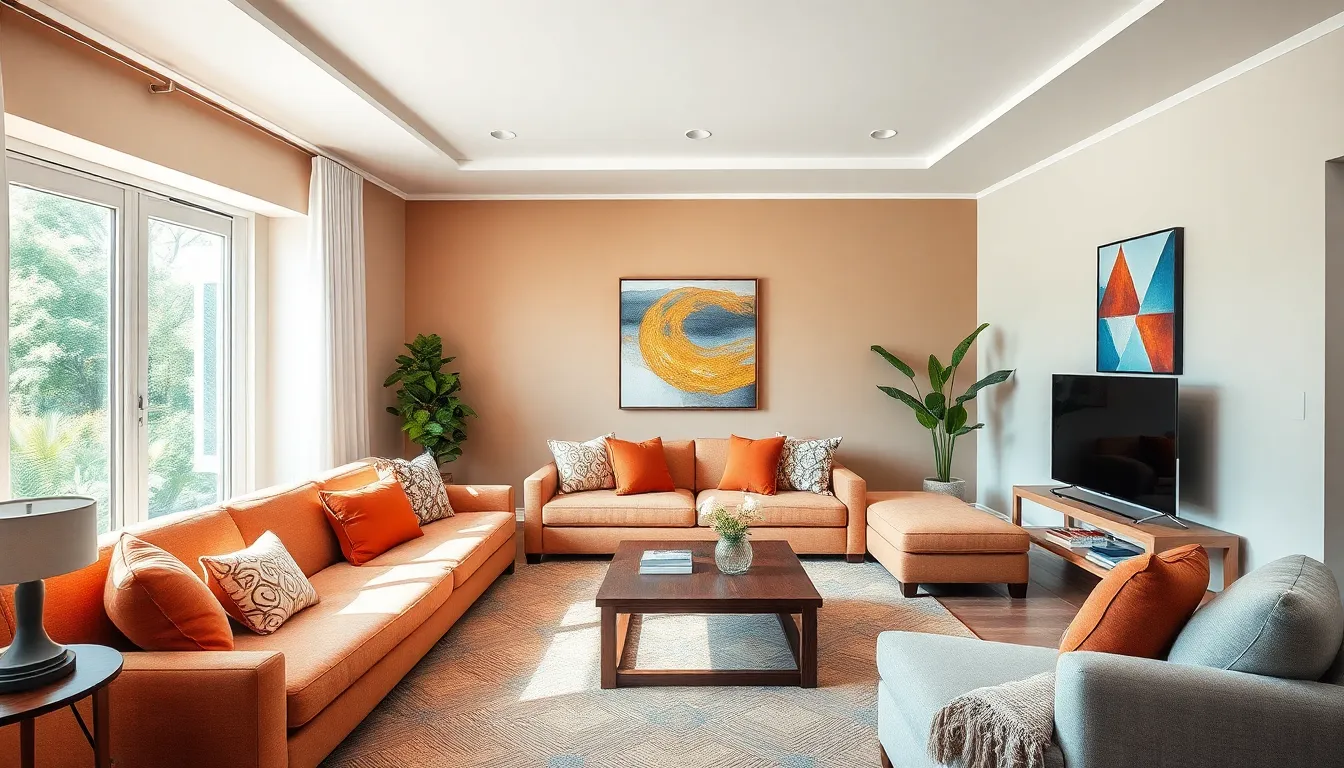In a world where bland walls and mismatched furniture reign supreme, decor and design have become the superheroes of home transformation. Imagine stepping into a space that not only reflects personality but also sparks joy. It’s not just about throwing a few pillows on the couch; it’s about creating an atmosphere that makes you want to dance like nobody’s watching (even if the cat is).
Table of Contents
ToggleOverview of Decor and Design
Decor and design play crucial roles in establishing a home’s character. Transformations in these elements can shift a space from bland to lively, creating an environment that promotes comfort and creativity. Effective design often incorporates color schemes, furniture arrangements, and decorative elements that reflect individual personalities.
Innovative decor styles vary widely, from minimalist and modern to vintage and eclectic. Each style offers unique aesthetics and functionality, allowing homeowners to express their tastes. Incorporating texture through fabrics and materials adds depth and warmth, making spaces more inviting.
In addition to visual appeal, thoughtful decor enhances functionality. Practical arrangements improve the flow of movement, ensuring ease of use. Combining aesthetic and functional elements leads to harmonious living spaces that foster well-being.
Choosing the right accessories, such as artwork, plants, and lighting, contributes significantly to the overall atmosphere. Accessories serve not only as focal points but also as ways to evoke emotions and memories. When selected carefully, these items personalize the space and create a cohesive look.
Colors significantly influence mood and perception. Warm tones, like reds and yellows, often stimulate energy, while cool tones, such as blues and greens, provide tranquility. The choice of colors alongside furniture and decor should align with the desired ambience.
Lastly, balancing design and decor requires continuous evaluation and adaptation. Keeping up with current trends and personal preferences allows spaces to evolve over time. Regular updates to decor ensure that environments remain fresh and engaging.
Key Elements of Effective Decor

Effective decor revolves around several key elements that enhance the overall aesthetic and function of a space.
Color Schemes
Color schemes exert a strong influence on atmosphere and emotional response. Warm colors like red and orange energize rooms, promoting activity and conversation. In contrast, cool colors such as blue and green instill calmness, encouraging relaxation. Choosing a cohesive palette streamlines design and unifies disparate elements. It’s essential to match colors with desired moods, ensuring spaces remain inviting and comfortable. Sticking to three to five colors in a scheme promotes harmony, avoiding overwhelming visuals. Accessories like cushions and wall art can introduce accent colors, providing interest without sacrificing balance.
Furniture Selection
Furniture selection significantly shapes a room’s personality and functionality. Choosing pieces that fit the scale of a room prevents clutter while maintaining harmony. Optimal selection involves prioritizing comfort and aesthetics, as both directly affect usability and visual appeal. Versatile furniture, such as expandable tables or modular sofas, enhances adaptability. Materials used should complement existing decor, contributing to the overall theme. In addition, it’s important to arrange furniture for easy movement, promoting a fluid atmosphere. Incorporating unique statement pieces can showcase individuality while tight integration with decor fosters a cohesive look.
Popular Decor Styles
Various decor styles appeal to different tastes and preferences. Each one offers a unique aesthetic and functionality that enhances living spaces.
Minimalist
Minimalism prioritizes simplicity and functionality. Neutral colors dominate, promoting a serene atmosphere. Furniture features clean lines, often with multifunctional pieces that save space. Essential decor only includes items that serve a purpose, reducing clutter and encouraging mindfulness. Open spaces reflect this style, allowing natural light to invigorate the environment. Accessories remain discreet, focusing on quality over quantity. Design elements work harmoniously to create a sense of peace and calm, which transforms the overall experience of the living area.
Bohemian
Bohemian decor thrives on vibrant colors and bold patterns. Layers of textiles, like rugs and cushions, contribute to the cozy vibe. Eclectic art pieces and vintage items tell personal stories, turning spaces into creative sanctuaries. Plants bring freshness and life, enhancing the earthy feel of this style. It’s not about perfection; it’s about embracing individuality and artistic expression. Spaces exude warmth and character, inviting relaxation and inspiration. A bohemian aesthetic often includes handmade items that add authenticity and charm, ensuring each room feels unique.
Industrial
Industrial decor embodies a raw and edgy aesthetic. Exposed brick walls and metal accents create a stark contrast with softer elements like wood and fabric. This style often showcases repurposed materials that add character and history to spaces. Open layouts emphasize functionality while highlighting architectural features. Lighting plays a crucial role; pendant lights and Edison bulbs enhance the industrial vibe. The use of neutral colors like gray and black creates a bold backdrop for statement pieces. Overall, this style represents urban living, effortlessly merging vintage with modern influences for a chic and sophisticated look.
The Role of Lighting in Design
Lighting serves as a crucial element in decor and design, influencing both aesthetics and functionality. Natural light enhances a space, creating an open atmosphere that uplifts mood. Artificial light adds depth, offering versatility through different fixtures and intensities.
Ambient lighting establishes a room’s overall brightness, while task lighting focuses on specific activities. Accent lighting highlights features, drawing attention to artwork or architectural details. Each type of lighting contributes uniquely, impacting how colors and textures appear throughout a space.
Selecting the right fixtures plays a vital role in achieving desired effects. Pendant lights often work well in kitchens, providing direct illumination and style. Floor lamps can add warmth and charm to living rooms, while wall sconces create balance and elegance in corridors.
Incorporating dimmers allows flexibility, letting residents adjust lighting based on the time of day or desired ambiance. Warm tones create inviting environments, while cooler tones evoke calmness. The right color temperature influences perception and mood, making thoughtful choices essential.
Layering light enhances dimension and drama. Combining multiple sources—such as ceiling lights, table lamps, and candles—creates a balanced feel. This approach fosters an engaging environment, encouraging relaxation or social interaction as needed.
As lifestyles evolve, the role of lighting adapts, emphasizing energy efficiency and smart technology. Sustainable lighting options, like LED bulbs, reduce energy consumption while providing beautiful illumination. Integrating intelligent systems also allows for customization, enhancing the living experience.
Understanding the impact of lighting on design allows homeowners to make informed decisions. By prioritizing lights that enhance both functionality and aesthetics, individuals can create spaces that are not only beautiful but also livable.
Sustainable Decor Practices
Sustainable decor practices focus on reducing environmental impact while enhancing living spaces. One key aspect involves using eco-friendly materials, such as reclaimed wood, bamboo, and recycled metal. Reclaimed wood offers unique textures and stories in furniture pieces, while bamboo stands out as a rapidly renewable resource.
Incorporating plants into interior design creates a connection with nature and improves indoor air quality. Air-purifying plants like snake plants and pothos are excellent choices for enhancing spaces. Opting for local artisans not only supports the community but also reduces carbon emissions from transportation.
Using non-toxic paints and finishes plays a significant role in creating healthier environments. Brands offer low-VOC or zero-VOC options that minimize harmful chemicals. Choosing second-hand or vintage items reduces waste and adds character to decor. Thrift shops and online marketplaces provide a treasure trove of unique finds.
Energy-efficient lighting options, such as LED bulbs, consume less electricity and last longer than traditional alternatives. Selecting furniture with an emphasis on durability and timeless design contributes to sustainability. Items that endure changing trends prevent frequent replacements.
Implementing waste-reducing practices matters, such as opting for durable textiles that withstand wear and tear. Natural fibers like organic cotton or linen serve as excellent options for upholstered furniture and window treatments. Lastly, embracing minimalism allows individuals to focus on quality over quantity, leading to intentional decor choices that reflect their values.
By prioritizing these sustainable approaches, individuals can create breathtaking living spaces that promote well-being while simultaneously caring for the planet.
Transforming living spaces through decor and design is not just an aesthetic choice but a pathway to personal expression and well-being. By thoughtfully selecting colors, furniture, and accessories, individuals can create environments that reflect their unique personalities and foster comfort.
Embracing various styles allows for creativity while ensuring that spaces remain functional and inviting. The integration of sustainable practices further enhances the impact of design, promoting a healthier planet alongside beautiful interiors.
Ultimately, the journey of decor and design is ongoing. Continuous evaluation and adaptation ensure that homes remain vibrant and aligned with evolving tastes and trends.




